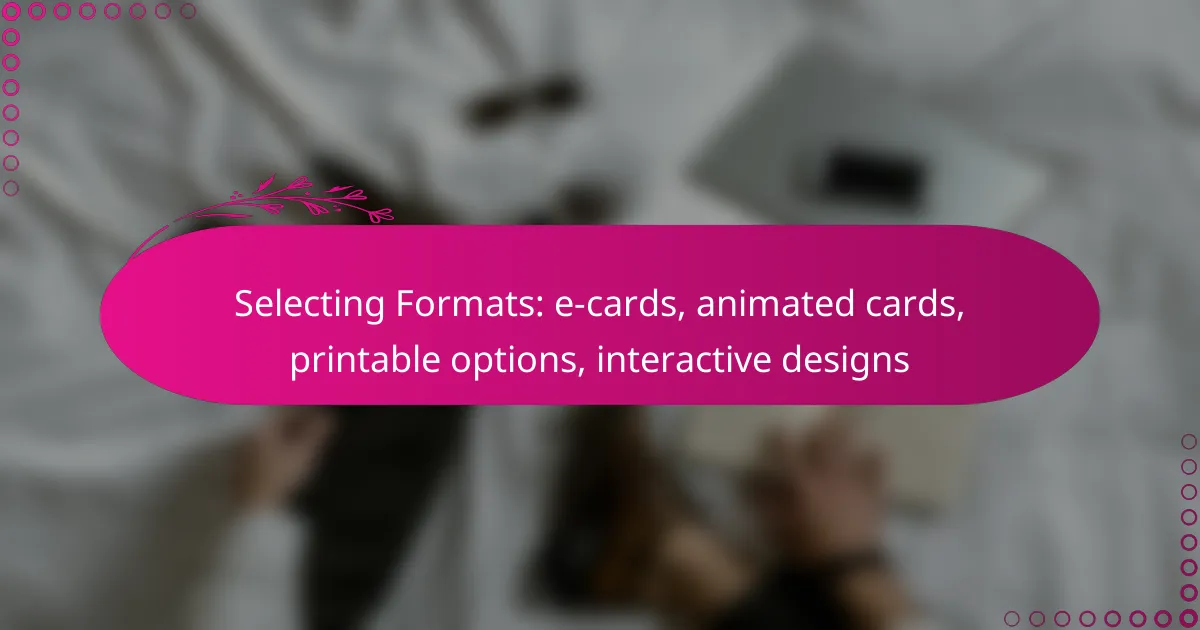When selecting the ideal format for your card, consider e-cards, animated cards, printable options, and interactive designs, each offering distinct advantages. Your choice should reflect the occasion, your audience, and the message you wish to convey, whether through visual appeal, user engagement, or the tangible nature of a physical card.

What are the best formats for e-cards?
The best formats for e-cards include digital, animated, printable, and interactive options, each offering unique benefits. Choosing the right format depends on your audience, the occasion, and how you want to convey your message.
Digital e-cards
Digital e-cards are electronic cards sent via email or social media, making them a convenient choice for quick greetings. They often feature customizable designs and can be sent instantly, which is ideal for last-minute occasions.
When selecting a digital e-card, consider the platform where it will be sent. Ensure compatibility with various devices and email clients to avoid display issues. Popular services like Paperless Post or Evite offer a range of digital options.
Animated e-cards
Animated e-cards add a dynamic element to greetings, using motion and sound to engage recipients. These cards can be particularly effective for celebrations like birthdays or holidays, where a lively presentation enhances the message.
Keep in mind that some email clients may not support animations, so it’s wise to include a static version or a link to view the animation online. Websites like JibJab provide fun animated e-card options that can be personalized.
Printable e-cards
Printable e-cards are designed for users who prefer a tangible card that can be physically delivered. These cards can be printed at home or through a professional service, allowing for high-quality designs and personal touches.
When choosing a printable e-card, consider the paper quality and size. Standard sizes like A5 or A6 are commonly used. Websites like Canva offer templates that can be easily customized and printed.
Interactive e-cards
Interactive e-cards engage recipients through clickable elements, games, or personalized messages. This format is great for creating a memorable experience, especially for tech-savvy audiences.
Ensure that the interactive features are user-friendly and compatible with various devices. Platforms like Smilebox allow users to create interactive e-cards that can include music and videos, enhancing the overall impact of the greeting.
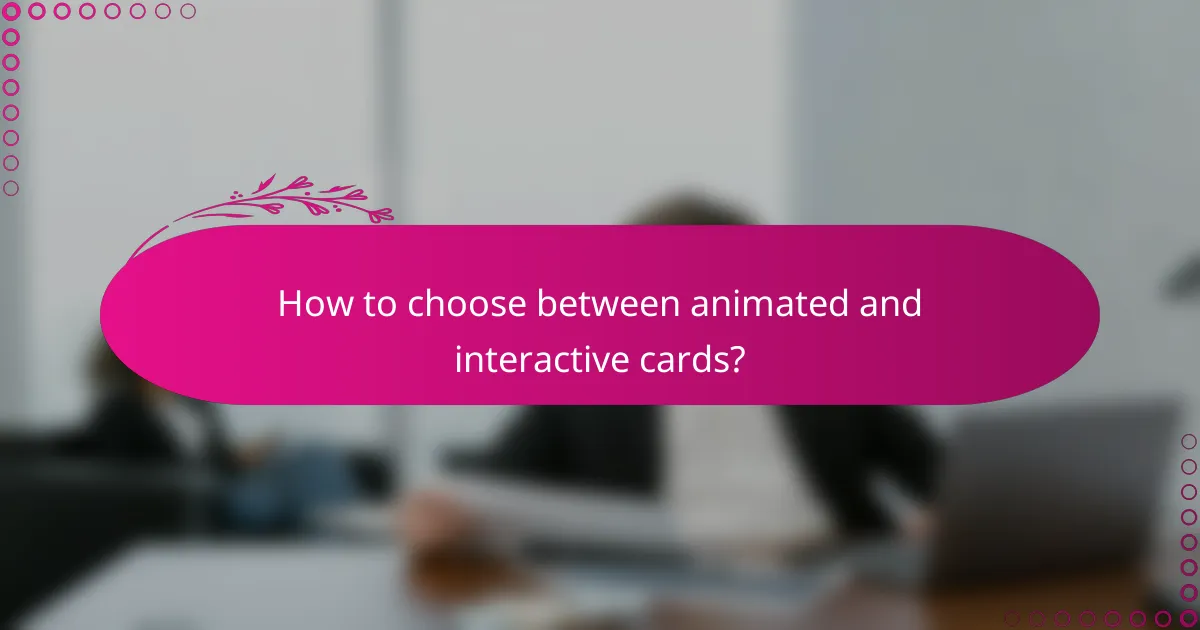
How to choose between animated and interactive cards?
Choosing between animated and interactive cards depends on the desired engagement and user experience. Animated cards provide visual appeal and can convey messages quickly, while interactive cards encourage user participation and exploration.
Engagement level
Animated cards typically capture attention through motion and visual effects, making them effective for quick messages or celebrations. They are ideal for situations where you want to evoke emotions or create a festive atmosphere.
In contrast, interactive cards invite users to engage directly with the content, often leading to higher retention and satisfaction. This format is suitable for educational purposes or when you want to provide detailed information that users can explore at their own pace.
Design complexity
Animated cards can be simpler to design since they primarily focus on visual elements and transitions. Basic animations can be created using standard tools, making them accessible for many users. However, achieving a polished look may require some design skills.
Interactive cards, on the other hand, often involve more complex design and development processes. They may require coding or specialized software to incorporate interactive features, which can increase the time and resources needed for creation. Consider your technical capabilities and the tools available when choosing this format.
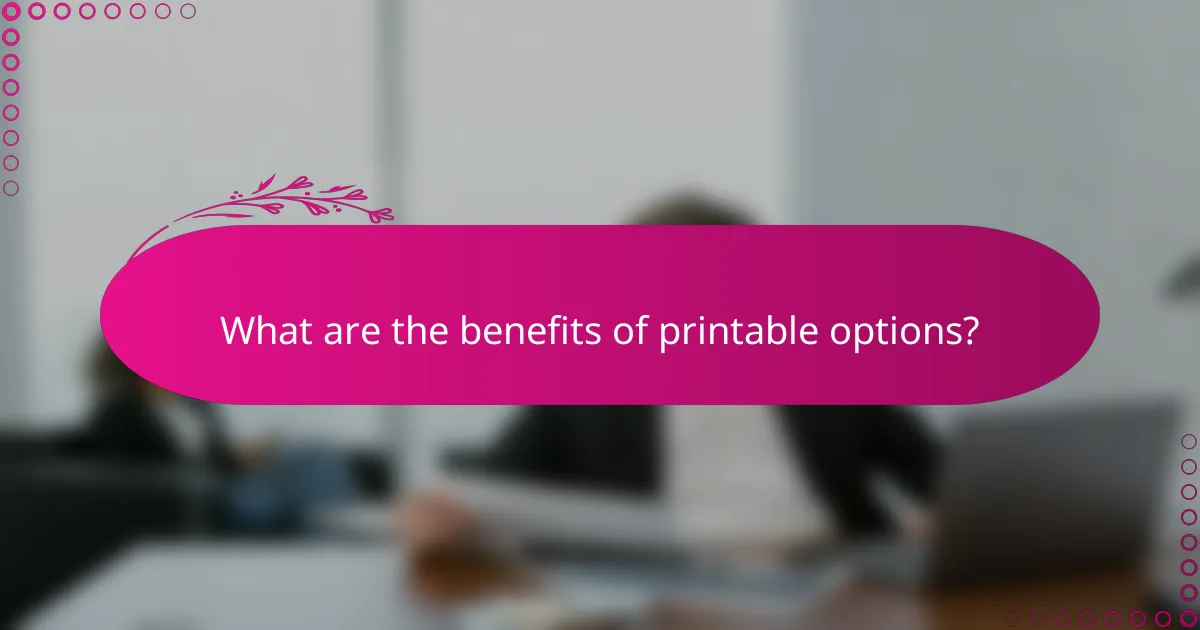
What are the benefits of printable options?
Printable options offer tangible benefits such as physical keepsakes and enhanced personalization. These formats allow recipients to hold a card in their hands, creating a lasting memory that digital formats may lack.
Physical keepsakes
Printable cards serve as physical keepsakes that can be displayed or stored. Unlike digital cards, which may be forgotten in an inbox, a printed card can be framed, placed on a desk, or kept in a scrapbook. This permanence adds sentimental value, making it a cherished item for years to come.
When selecting a printable option, consider the quality of the paper and printing. High-quality cardstock can enhance the visual appeal and durability, ensuring that the card remains in good condition over time.
Personalization opportunities
Printable options allow for extensive personalization, from custom messages to unique designs. You can easily tailor the card’s content, colors, and images to match the recipient’s preferences or the occasion. This level of customization can make the card feel more special and meaningful.
To maximize personalization, consider using templates that offer various design elements. Many online platforms provide tools to add photos, change fonts, and adjust layouts, making it simple to create a one-of-a-kind card that reflects your style and sentiment.
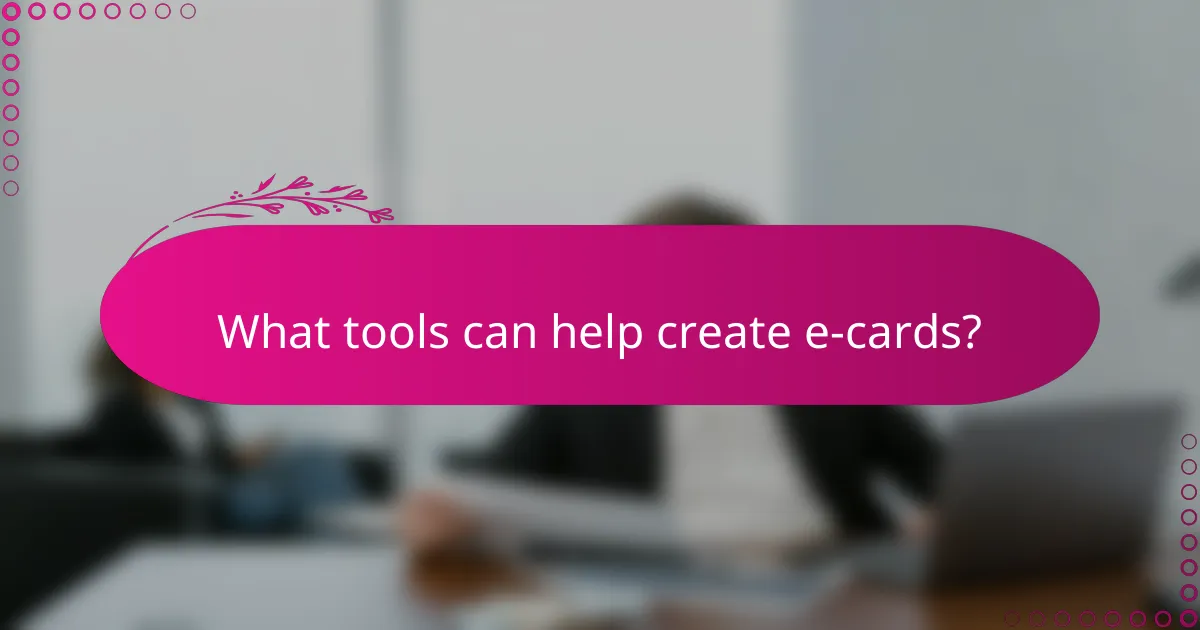
What tools can help create e-cards?
Several tools can assist in creating e-cards, each offering unique features and capabilities. Popular options include Canva, Adobe Spark, and Smilebox, which cater to different design preferences and user experiences.
Canva
Canva is a user-friendly design platform that provides a wide array of templates for e-cards. Users can easily customize these templates with their own images, text, and colors, making it suitable for both beginners and experienced designers.
One of Canva’s strengths is its drag-and-drop interface, which allows for quick adjustments. Additionally, it offers both free and premium options, with the latter providing access to a larger library of design elements and features.
Adobe Spark
Adobe Spark is another powerful tool for creating e-cards, known for its professional-quality designs. It allows users to create visually appealing cards with ease, utilizing its vast selection of templates and customization options.
Adobe Spark integrates well with other Adobe products, making it a great choice for those already in the Adobe ecosystem. Users can also share their creations directly on social media or download them for printing, offering flexibility in how the e-cards are used.
Smilebox
Smilebox specializes in animated e-cards and interactive designs, making it a fun option for users looking to add a dynamic touch to their greetings. It offers a variety of templates that can be personalized with photos, music, and messages.
This platform is particularly advantageous for those who want to send engaging, multimedia e-cards. However, some features may require a subscription, so users should consider their needs before committing to a plan.
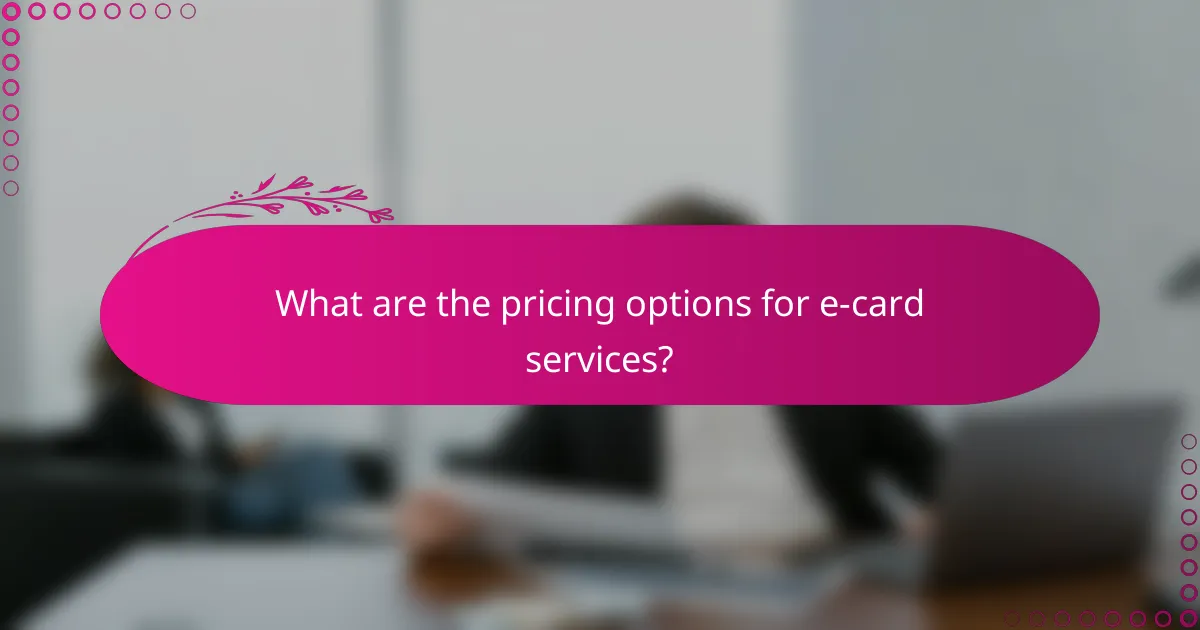
What are the pricing options for e-card services?
E-card services typically offer a range of pricing options, from free templates to subscription plans. Understanding these options can help you choose the best service that fits your needs and budget.
Free templates
Many e-card platforms provide free templates that allow users to create and send cards without any cost. These templates often come with basic designs and limited customization options, making them suitable for casual use.
When using free templates, consider the quality of the designs and whether they meet your specific requirements. Some platforms may include ads or watermarks on free cards, which can detract from the overall presentation.
Subscription plans
Subscription plans for e-card services generally offer more features, including access to premium designs, enhanced customization, and the ability to send unlimited cards. Prices for these plans can vary widely, often ranging from a few dollars per month to around $100 annually.
When choosing a subscription plan, assess how frequently you plan to send e-cards and whether the additional features justify the cost. Look for trials or money-back guarantees to evaluate the service before committing long-term.
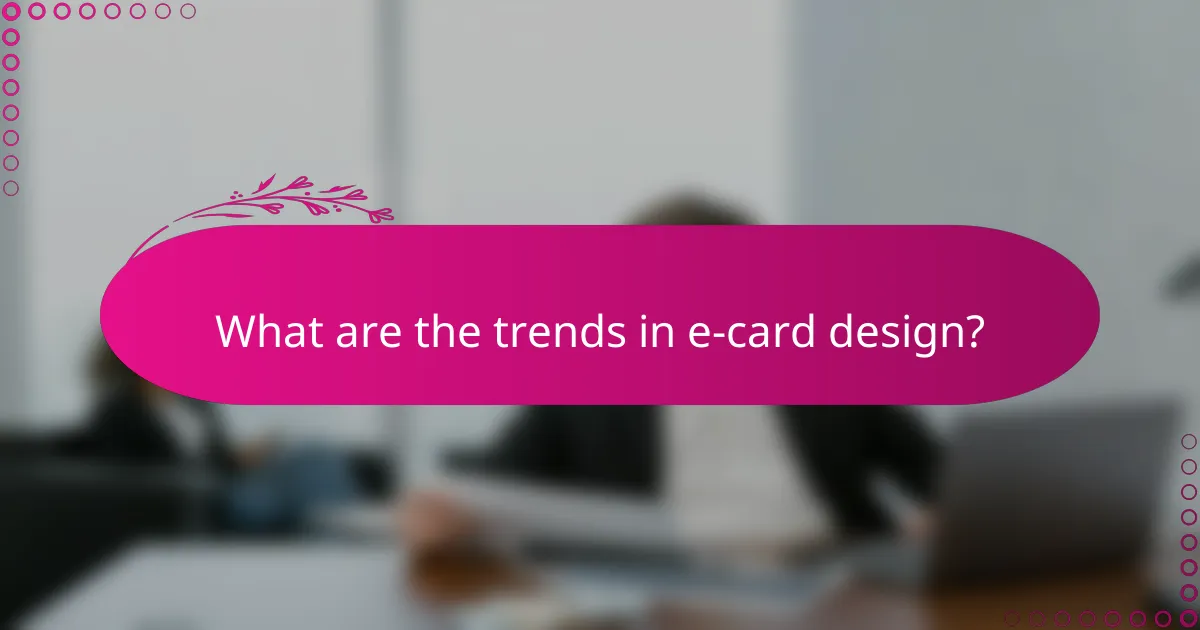
What are the trends in e-card design?
Current trends in e-card design focus on sustainability, interactivity, and enhanced user experiences. Designers are increasingly incorporating eco-friendly materials and innovative technologies to create engaging and memorable digital greetings.
Sustainable materials
Sustainable materials in e-card design emphasize eco-conscious choices, such as recycled paper and biodegradable inks. These options reduce environmental impact while appealing to consumers who prioritize sustainability.
When selecting e-cards, consider brands that use these materials to align with your values. For instance, choosing cards made from 100% recycled content can significantly lower your carbon footprint compared to traditional options.
Augmented reality features
Augmented reality (AR) features in e-cards enhance user engagement by allowing recipients to interact with the card in a dynamic way. For example, scanning a card with a smartphone can reveal animations or additional messages, creating a memorable experience.
When designing or choosing AR-enabled e-cards, ensure the technology is user-friendly. Look for options that do not require complicated setups, allowing recipients to easily access the interactive elements with just a simple scan.
